My desire for a good automation/base building game was well satisfied by… Satisfactory a little while back but that doesn’t mean I was completely out of the market for that kind of experience yet. So when I saw that Factorio had gone 1.0, after what seemed like an eternity in Early Access, I figured it wasn’t a bad time to get into it. Also now that I’m equipped with the relevant experience in a few titles I feel more justified in my opinion that, whilst Factorio certainly meets many of the criteria I’ve set for what makes a game like this good, there just a few minor niggles and a lack of that X factor to really draw me fully in. I can definitely see why many have been though but I think a combination of a few minor factors was enough for me just to get through the basics of the game and then not really feel compelled to go any further with it.
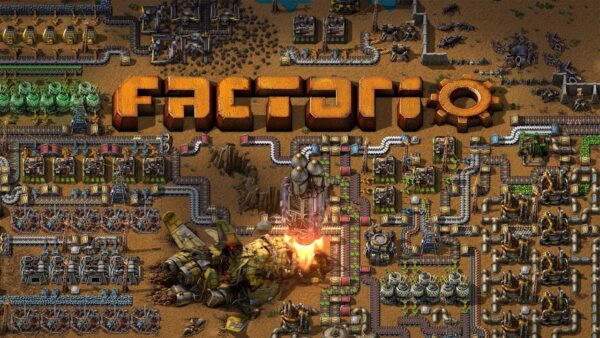
Factorio does have a light plot although it’s really nothing beyond what most of these games have. You’ve crash landed on a planet and in order to escape you must work your way up from digging minerals out of the ground with your hands all the way up to gigafactories spanning a good percentage of the world so you can craft yourself a way off it. There might be more to it but I didn’t go through the tutorial fully, instead opting to jump out of it early so I could really get into the meat of the game: automating the bejeezus out of everything.
The graphics remind me of those old school games that used 3D models to make sprites for their games as everything has that same look and feel that they did. The focus here is most certainly not in the detail as you’ll be spending the vast majority of your game time zoomed out as far as you can possibly go so you can keep an eye on as much as you can at once. Thankfully most of the items, buildings and interconnects have distinct visual elements or colours so it makes it relatively easy to find something in the godforsaken mess that your factory will inevitably become. This also helps with performance as I’m sure things start to get a little bit complicated as your factory starts needing things like, you know trains, just to move items from one part of it to the other.
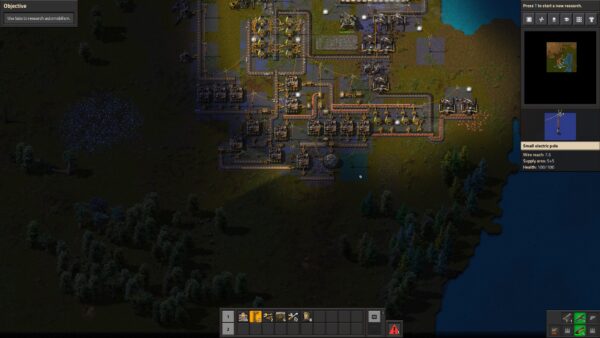
The standard base building/automation game tropes are present here, having you start off by mining and crafting a lot of things by hand before you start progressing up the automated build chain. Resources start of basic and usually pretty plentiful but soon work their way up to being more scarce and needing a lot more effort from you in order to utilise them. Unlike others whereby you unlock tech by completing milestones or simply making a bunch of a particular item Factorio instead has a dedicated tech tree along with its own input requirements, meaning that you’ll need to dedicate an entire supply line to ensuring you move up the tech tree. The biggest difference I saw though was the addition of combat which, while simple, does mean that your factory isn’t a (mostly) set and forget exercise. This is definitely one of those games where you can see the years of Early Access at play in the final product as there’s been a lot of effort put into the game’s various mechanics.
Combat is very simplistic as whilst on the surface it looks like a kind of twin stick shooter deal in essence it’s a single stick one since you don’t have to aim. This makes most encounters a simple affair of circle strafing around so you can kill the enemies off before they have a chance to take you down. There are more devastating and interesting weapons available to you should you research them but for the most part they seem to do the same job, just some of them do it a little bit better for certain things (submachine gun for bugs, shotgun for their base). However its impact on the game is probably one of the biggest sources of frustration for me as once you get to a certain point you’ll be fending off attacks pretty regularly which means dedicating a not insignificant amount of time to rebuilding your base and defenses. Reading the forums this seems to be largely taken care of at higher tech trees but this was one of those “factors” I mentioned earlier that led to me putting it down.
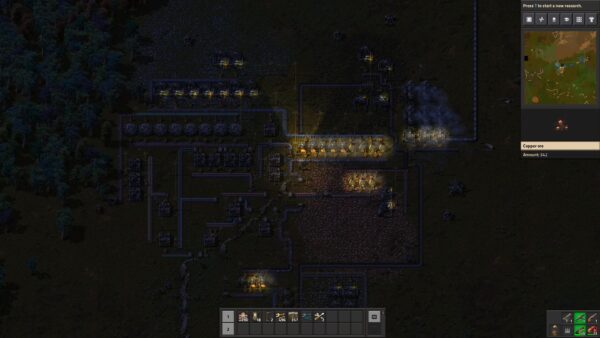
The progression up the automation tree is well paced and thought out, guiding you in such a way that you’re often building upon your previous automated layers rather than having to tear them down and build them back up again. Whilst I didn’t look at any optimised factory layouts I did come across some of the more rudimentary build ideas (like item buses) when I was looking for clarification on how certain things worked. These ideas definitely helped out in getting some of the basics right although some of the game’s…foibles, such as conveyor belts having 2 siders and the arms only being able to load onto one of them (the far side), did make constructing things a bit more challenging than I think they needed to be. Often this just mean laying out the conveyor belts first before building anything else, ensuring that I had the right items on the right sides so I wouldn’t end up with production bottlenecks.
Which is something you’ll be dealing with constantly as with any highly automated system it doesn’t take much to send it for a wobbly. Usually this comes in the form of a lack of input resources which, more often or not, means that one of your miners has run dry and you’ll need to relocate it in order to get production back up to speed. This also happens quite a lot when you upgrade the tech level of an item (say stone furnace to steel) as depending on how you do it you may end up causing supply issues upstream which will, again, lead to production bottlenecks at your desired output. Thanks to the super zoom out it’s usually not too hard to track down why something is going wrong but once your factory gets to a decent size, with numerous underground belts to boot, things start to get taxing.
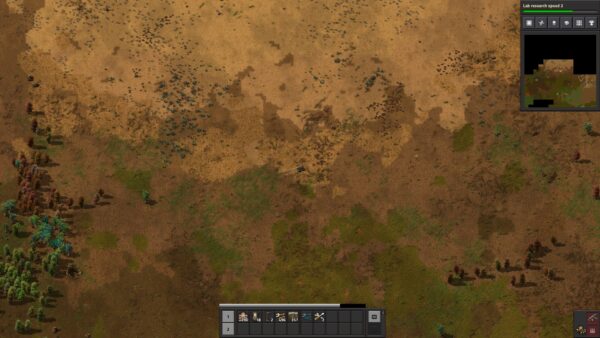
In the end most of it comes down to ensuring you’ve got a layout that can be scaled horizontally as far as you can. Because without that you’re highly likely to get to a point where you want to produce an item and you simply won’t have enough of some particular input in order to make it work. This will mean you’ll either have to turn off factories, divert resources or do something else which will upset some other form of production, likely causing you some other heartache down the line. Of course once you know how to set these kinds of things up (I think I have some of the basics of unlimited horizontal scaling demonstrated below) things get a bit easier but then you’ve got to, you know, scale them.
It’s at this point I ran out of steam with Factorio as whilst I was having fun up until that point the fact that research kept taking longer, which mean I needed to scale basically all means of my production even more, I just didn’t really feel like continuing at that point. To be sure I can see the appeal of having a factory you come back to every so often to scale out a bit, tweak some things here or there, as you work your way up the tech tree over a few hundred hours. But for me that lack of something additional to drive me forward, like the story in Subnautica for instance, meant that I just didn’t feel like playing more. Perhaps playing with friends could’ve combated that, I don’t know as it seems all my Factorio playing friends are busy enough with their own factories.
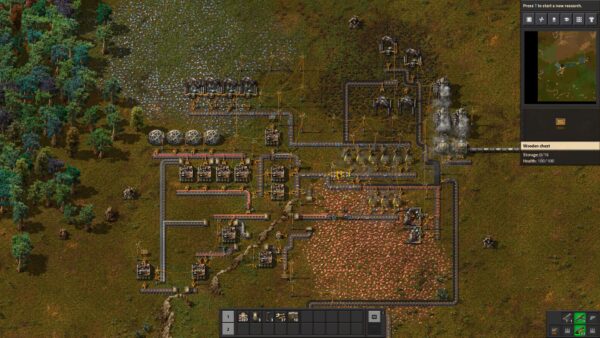
Factorio has all the right ingredients for folks who love to spend countless hours building out their factories and optimising them to the nth degree. The simplistic yet visually distinct visuals ensure that you won’t have to play a game of hide and seek with your supply chains. Mechanically everything is sound; the game definitely a product of multiple years of polish thanks to its time in Early Access. However there’s just enough things that rub me the wrong way with it that I don’t think I’ll be spending much more time in it, save for when my mates read this and want to show me what Factorio is really about.
Rating: 8.0/10
Factorio is available right now on PC for $42. Total play time was 7.2 hours with 0% of the achievements unlocked



